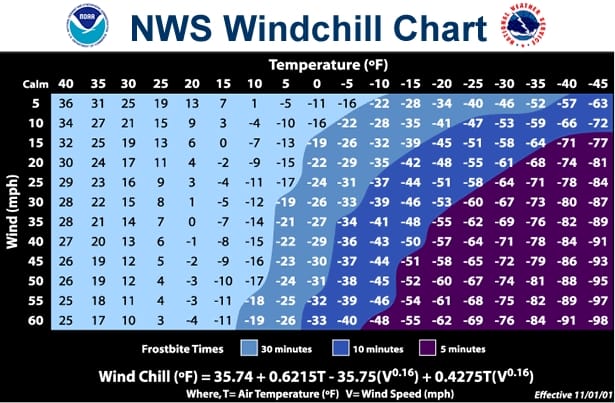The Washington Post has an introductory article by Valerie Strauss explaining wind chill. It was surprising to me that accurate wind chill wasn’t determined until recently.
In 2001, the U.S. government started using a more precise way to measure wind chill by testing how quickly people’s skin froze. Twelve volunteers were placed in a chilled wind tunnel. Equipment was stuck to their faces to measure the heat flow from their cheeks, forehead, nose and chin while they walked three miles per hour on a treadmill. One of the things they learned was how quickly frostbite develops on exposed skin. The information collected from the volunteers helped scientists come up with the complicated formula involving wind speed and air temperature to compute wind chill. For example, if the temperature is zero degrees Fahrenheit and the wind is blowing at 15 miles per hour, the wind chill is calculated at 19 degrees below zero. At that wind chill temperature, exposed skin can freeze in 30 minutes.

www.nws.noaa.gov/om/windchill/index.shtml
Windchill temperature is only defined for temperatures at or below 50 degrees F and wind speeds above 3 mph. Bright sunshine may increase the wind chill temperature by 10 to 18 degrees F. The new Wind Chill Table index:
- Calculates wind speed at an average height of five feet (typical height of an adult human face) based on readings from the national standard height of 33 feet (typical height of an anemometer)
- Is based on a human face model
- Incorporates modern heat transfer theory (heat loss from the body to its surroundings, during cold and breezy/windy days)
- Lowers the calm wind threshold to 3 mph
- Uses a consistent standard for skin tissue resistance
- Assumes no impact from the sun (i.e., clear night sky)
For those wishing a more precise calculation than that provided by the table the NOAA website provides a Wind Chill Calculator where you can enter your exact temperature and wind speed to determine the precise wind chill factor.
Dress warm!
Follow our occasional Tweets @WinterCampers
SHARE
November 1st, 2010 | Tags: Wind Chill | Category: Cold Weather Camping, Snow Hiking, Winter Camping Skills
Comments are closed.

